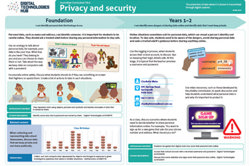Years 9–10: Data science skills
This unit introduces data science as a process, focusing on specific skills used in data science. These include the acquisition of data from surveys, sensors or online repositories; storage and analysis of that data; and its visualisation, including with interactivity. When acquiring and analysing data, students can apply the Australian Privacy Principles formally introduced in the years 9–10 Cybersecurity unit. They can also build on the database and spreadsheet skills introduced in the years 7–8 Working with data unit, now querying relational databases and using more advanced spreadsheet formulas and functions.
Additional details
| Year band(s) | 9-10 |
|---|---|
| Content type | Scope and sequence, Whole School |
| Format | Web page |
| Core and overarching concepts | Privacy and security, Data acquisition, Data interpretation |
| Australian Curriculum Digital Technologies code(s) |
AC9TDI10P01
Develop techniques to acquire, store and validate data from a range of sources using software, including spreadsheets and databases
AC9TDI10P02
Analyse and visualise data interactively using a range of software, including spreadsheets and databases, to draw conclusions and make predictions by identifying trends and outliers
AC9TDI10P03
Model and query entities and their relationships using structured data
AC9TDI10P07
Design and prototype the user experience of a digital system
AC9TDI10P14
Apply the Australian Privacy Principles to critique and manage the digital footprint that existing systems and student solutions collect |
| Keywords | scope and sequence, scope, sequence |
| Integrated, cross-curriculum, special needs | Mathematics, Digital Literacy, Critical and creative thinking |
| Organisation | ESA |
| Copyright | Creative Commons Attribution 4.0, unless otherwise indicated. |
Related resources
-

GenAI readiness and implementation modules
As generative AI (GenAI) becomes an increasingly important tool in education, it's essential for teachers to understand both its potential and its limitations. This two-module offering equips teachers with the knowledge and practical skills to use GenAI tools like Copilot effectively in the classroom. Teachers will enhance their own digital literacy while learning how to guide students in using AI responsibly and thoughtfully. By focusing on teacher readiness and practical classroom strategies, the modules support the development of students who can navigate AI in both classroom and everyday contexts. The modules were developed in collaboration with Microsoft.
-

AI readiness: Preparing teachers for safe and effective use of GenAI
The module aims to increase teacher readiness when using generative AI (GenAI). It builds teachers' own digital literacy around GenAI and equips them to develop their students’ digital literacy capabilities. It is aimed at Australian F–12 teachers interested in learning about and exploring the use of generative AI for streamlining admin tasks and personalising learning, safely and responsibly. The module was developed in collaboration with Microsoft.
-

Years 9–10: Cybersecurity
This unit considers how and why data is kept secure on the internet. Students refresh and build on their understanding of network hardware and internet protocols.
-

Acquiring, analysing and visualising data: 7-10 infographic
Data acquisition is a core concept of Digital Technologies. Data acquisition includes a focus on collecting data via survey and questionnaire and using existing datasets such as those available in online repositories. This infographic is designed to assist in the interpretation of the Australian Curriculum V9.
-

Privacy and security: F-10 infographic
Privacy and security is a core concept that is introduced in Foundation and continues through to Year band 9-10. View the poster for your Year band for an explanation of the concept with relevant examples and ‘I can’ statements. Use the posters to support planning and assist in implementing the Australian Curriculum Digital Technologies V9.0.
